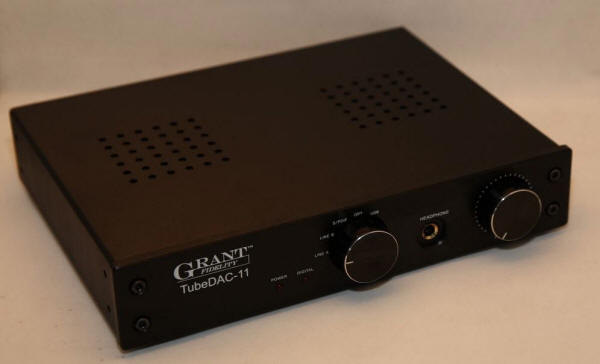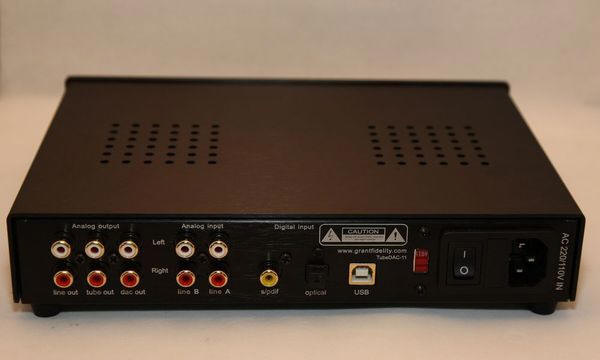|
You are reading the older HTML site
Positive Feedback
ISSUE
58
The Neoteric Listener and the Grant Fidelity
TubeDAC-11
What should I buy? Which one is best? Just tell me what I want, how to get it, and don't confuse me with questions! Ah, the unmistakable sounds of the holidays. Who doesn't recognize the breathless exhortations of friends and family who come to us—music enthusiasts who spend far too many waking (and dreaming) hours in search of the perfect product—only to be dragged into our audiophile quicksand of premium fuses, standing room nodes, and sampling rate esoterica. When taunted to name names, some of us crumple and blurt out any model that will get us off the hook. But deep down, we know, you know... so many variables, so many models, toooo many choices! But no such dilemma exists with entry level DACs. Nope, when it comes to entry level DACs, I'm a veritable Sorting Hat, confidently matching all devices, timid and brave, to their respective halls of listening. Gimme a price point and functions required, and, presto-soundo!, I pull from my, uh, magic bag, an HRT Music Streamer II+, or CEntrance DACport, or Furutech ADL GT40. All of these DACs are relatively affordable, all of them offer various options and design features...and all of them sound different from each other. Some skew towards a leaner, more analytical approach, while others are closer to the BIG SOUND camp, but each is a great choice, depending on your budget and needs. Naturally, I have heard some DACs in this $100-$500 price range that just plain old suck, but there's no need to mention them, even for sport.
And now there's a new player on the scene, the Grant Fidelity TubeDAC-11, which offers wonderful sound and a holiday sack of features at a price that you can quote without trepidation. Straight off, the TubeDAC-11 has one of the quietest backgrounds of any of the DACs I've encountered. You'd think its 6N11 vacuum output tube would warm it up like a viscous winter's porridge, but this is more like a Chinese clear soup––opaque but with a pleasant hint of flavor. Ok, flawed comparison (soup is lousy playback medium) but what is clear is that the TubeDAC-11's Cirrus Logic CS4398 chip offers a really nice balance of imaging, resolution, and sweet midrange in its handling of computer audio files. I spent most of my time listening to the Grant Fidelity with my Macbook Pro connected via a Wireworld USB cable and utilizing the DAC's tube output. I relied on my usual Arcam A-80 integrated amp, a new Peachtree Audio iNova integrated, and an Ayon Orion II integrated tube amplifier (review pending). Speakers included a pair of Tannoy Eyris Ones and a pair of Nola Boxer standmounts. Stereolab, Kimber, and Harmonic Technology interconnects paired with Kubala Sosna and Nordost entry level speaker cables were switched in and out, as needed. My small 10' x 11' listening room is virtually untreated, save a few bookshelves and the occasional bowl of cereal on Saturday mornings. The TubeDAC-11 supports 24bit/96 KHz via USB and 24/192 high res signal via the optical or digital input (input options include two RCA, one coaxial, one optical and one USB). While the TubeDAC11‘s higher res sound is really quite special, my 24/192 files are the typical audiophile costume jewelry that makes for a measurable, miserable experience. So I mainly listened to music that I actually enjoy, using Pure Music and the USB input. Purchasers are encouraged to try out all the options, however, as Grant Fidelity is kind enough to conveniently package one RCA, Coaxial, Optical, and USB cable with every TubeDAC-11.
For full disclosure, my audio preferences are tape and vinyl, yet my home listening is entirely computer audio and CDs, so I rail at DACs for being "can'talog," while demanding that they possess some degree of analog quality. I suspect that I'm not alone in this dilemma, hence the review. To be honest, it's tough for any DAC, even the big guns at Pentagon prices, to render the presence and solidity without straying into the audio land of make-believe. The Tube-DAC-11 avoids the brittleness that comes from trying to be the last word in resolution and dynamic range, and opts, instead, for a relaxed sound that should appeal to many listeners and a variety of genres. Rock music, in particular, benefitted from the lack of stridency that bedevils many of the TubeDAC-11's competitors. The TubeDAC-11's strong suit is a wide soundstage and a believable representation of vocals, piano, and string instruments. You probably won't be to wrench slam, impact, and all of those other NASCAR audio effects from the Grant Fidelity, but you can count on tonal accuracy and no trace of even the slightest listening fatigue. There seems to be a concerted effort to retain the delicacy of a musical performance, an accomplishment largely achieved by an impressive spatial separation and depth. The tube output slightly juices the midrange, which helps take the edge off the slightly aggressive tone of the Arcam amp, making this DAC a good option for those who, like me, employ entry to mid-level solid state amps when playing audio files or streaming internet radio. Moreover, I found that the tube output option was a terrific choice when using my Arcam CD82 player as a transport and utilizing the Grant Fidelity DAC. This is no big surprise, given that the Arcam is getting on in years, but almost every aspect of playback was enhanced by the pairing. My favorite combination for listening to both CDs and computer files, however, came from using the transistor output in conjunction with the Ayon Orion II tube integrated amp. The rich, musical tone of the Ayon only needs an accurate, faithful source, no home squeezins' required, and the TubeDAC-11 works best with systems that don't need tone-shaping plastic surgery. The tube option, however, paired with the Ayon eventually became too warm for my taste, but I should note that Grant Fidelity has provided a number of ways to alter the sound of the TubeDAC-11. The volume knob used to adjust the output stage level (6V RMS max for the tube and line output) is remarkably handy in modifying the sound, and I was amazed at how closely I could emulate the sound of other DACs I've heard just by monkeying around with the dial. Personally, I found the setting of three o'clock to give the most satisfyingly rich presentation, especially when paired with the Arcam and Peachtree Audio amps, but those with a sufficiently warm system may prefer a leaner (and probably more accurate) lower setting. Other DACs in my experience deliver the lowest frequencies more effectively, but the Grant Fidelity's bottom notes are of respectable quality and control for all but the most tuba-rific material. As noted earlier, there are many DAC options for the holiday shopper: some are cheaper than the Grant Fidelity, a few the same, and many more are much pricier. But few of these DACs can also be used as a preamplifier. Or you can use it in conjunction with your Blu-ray player, ipad, tape player, phono stage, gaming and/or cable box, wireless audio device, iPod, and, well, you get the idea. The TubeDAC-11 is a fine DAC on its own, and probably most people will just use it in this capacity, but the fact that it offers so many other features (including a headphone amp!) make it an especially fine value. As a final note, my communication with Grant Fidelity via the main website (no audio reviewer Batphone here) was both immediate and productive. The TubeDAC-11 is a welcome addition to the DAC world, and I suspect will be just the thing to recommend this holiday season. Recommended.
Grant Fidelity TubeDAC-11
$325
|



